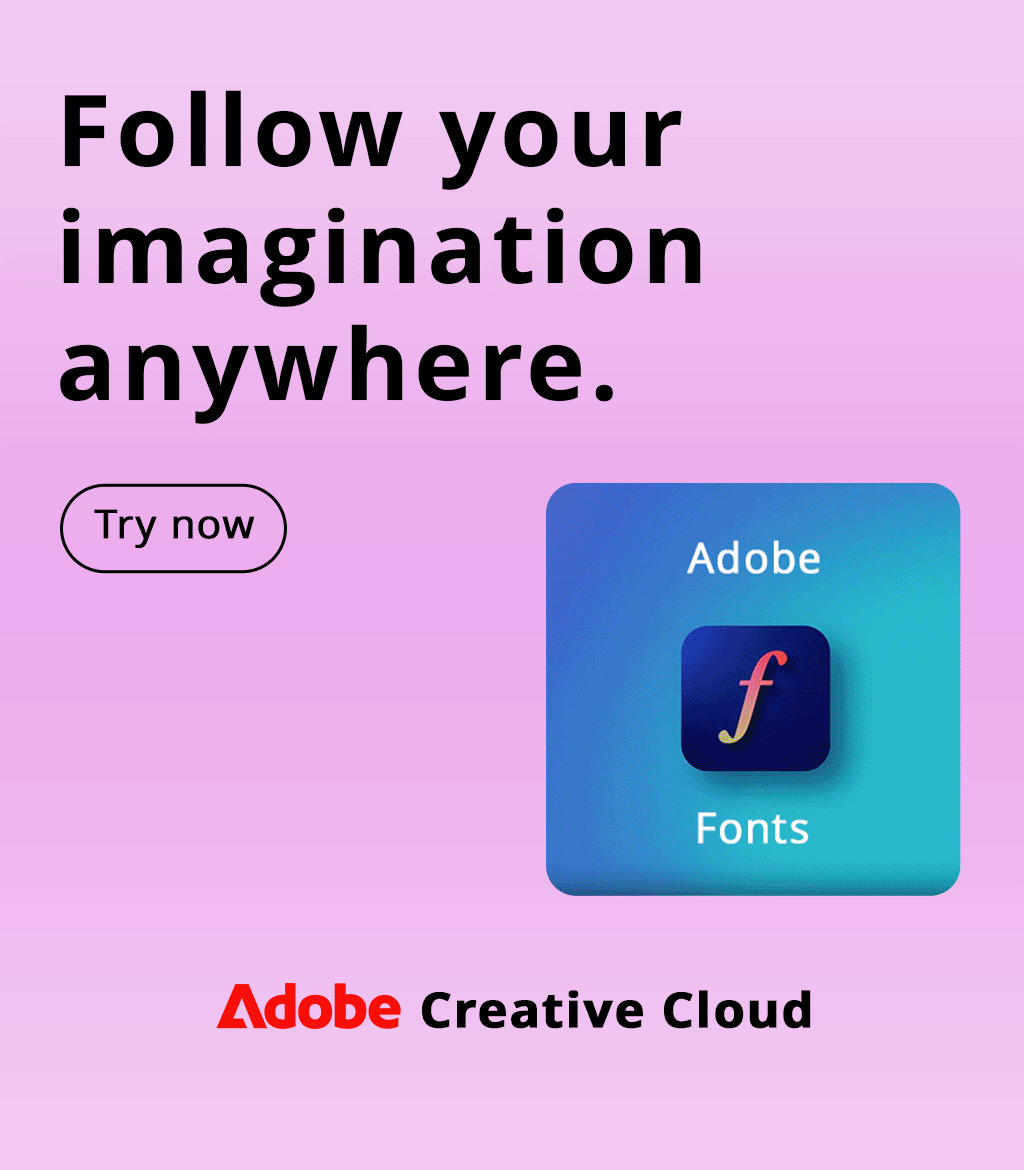Aperture and Depth of Field – Focusing Basics

Why Small Aperture has large depth of field? Which aperture gives the greatest depth of field? At what aperture is everything in focus? If you’re interested in these questions, read more about aperture and depth of field’s basics and how these camera settings affect your photos.
Aperture and Depth Of Field: Basics
Take a deep dive into the camera lens characteristics. I’ll try to explain everything you need to know about f-stop, focal length, focus range, and field of view in detail. Apart from basics, you will learn technical details which will give your shooting more confidence.
Aperture in Photography
Many beginning photographers mistakenly think that aperture and f-stop are identical, which is wrong.
Aperture means the diameter of the aperture through which the light hits the camera lens.
F-stop (f-number or f-stop value) is focal length divided by the diameter of the aperture. F-stop is a dimensionless value, which is usually indicated by “f”. The number which underlies “f” indicates the f-stop value.
The shorthand “f” means f-stop like the “s” often stands after a shutter speed because it is measured in seconds. For example, f/2 and f/8 are common f-stop settings, where 2 and 8 are determined as the f-stop values, correspondingly.
The diameter of the aperture is a straight line distance from one side of the aperture to the other side, going through the center of the aperture.
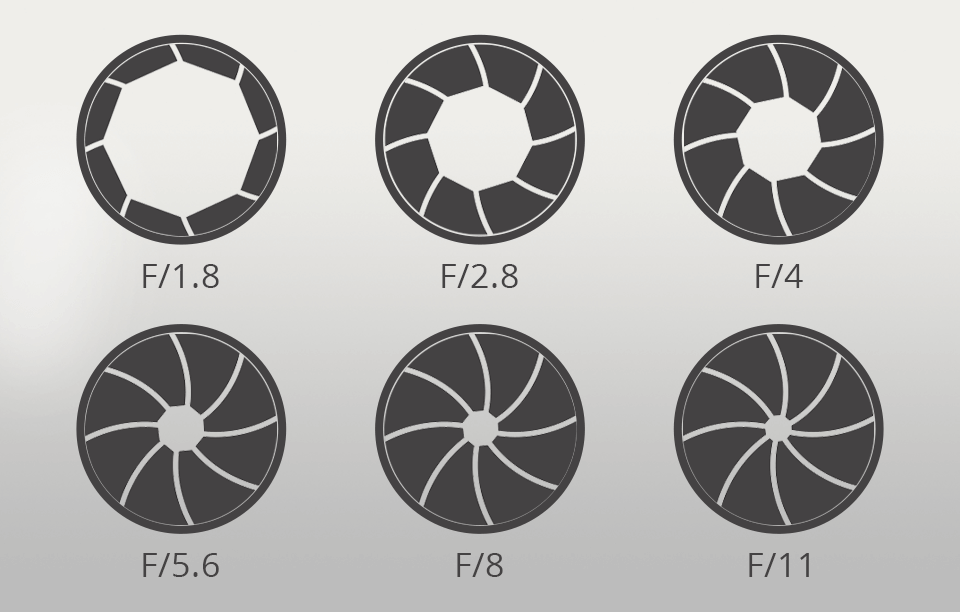
The focal length of the lens affects the composition as well as magnification and FOV (field of view). Look at the section below to examine the graphic. You will see that as the f-stop value increases, the aperture opening reduces.
For instance, the focal length is 50mm and the diameter of the aperture is 25mm. In this case, f-stop = 50mm/25mm = 2 (f/2).
If the focal length is 400mm and the aperture opening is 50 mm, then we can easily count the f-stop number. f-stop = 400mm/50mm = 8 (f/8).
Usually, shooters define the f-stop value and focal length using the camera adjustments. They control the appropriate aperture diameter at the point where the light reaches the camera lens. A large f-stop number means less light entering the camera lens. Respectively, a small f-stop number means you let more light in.
- Learn more about recommended camera settings for portraits.
Depth of Field in Photography
This parameter has abbreviation DOF and photographers also call it a depth of focus. By the way, the focus range and DOF are interchangeable terms.
So, the depth of field is determined as a particular distance between the nearest and the furthest objects in a frame that are both sharp. All elements between the nearest and the furthest objects are in focus as well. To control DOF, it is necessary to set the f-stop value.
Smaller f-stop value means larger aperture opening and, consequently, smaller depth of field
Larger f-stop value means a smaller aperture opening and larger depth of field
These samples give the visual understanding of the shallow depth of field and deep depth of field. Examine the photos and follow the explanations to have a deeper insight into the matter.
The first photo is shot at f/5.6 and the second one at f/16. Rocks on a beach depicted in the image allow you to understand how the depth of field makes a difference to the overall look of the picture.
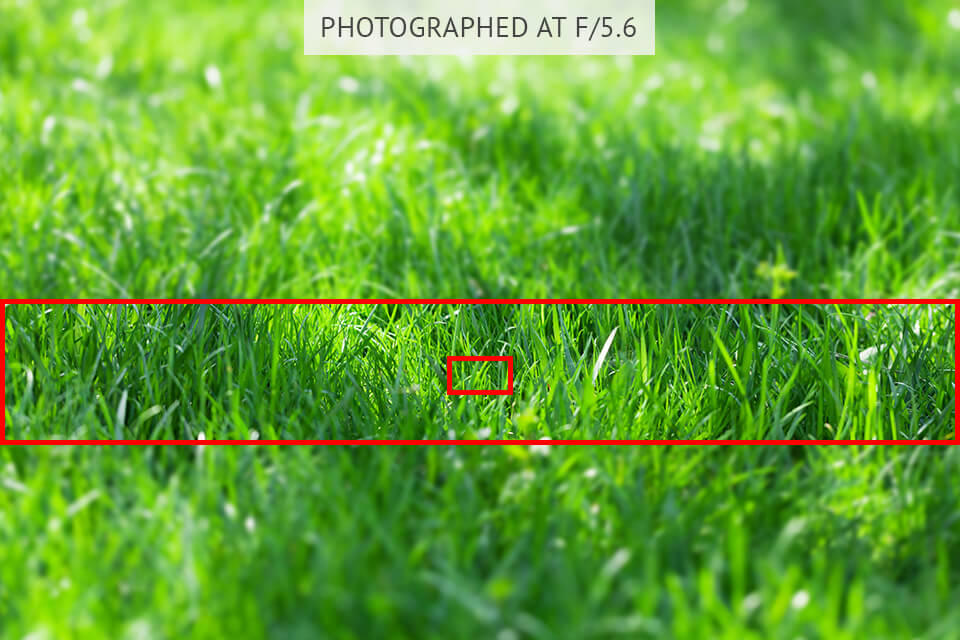
The red lines indicate the nearest (bottom) and distant (top) objects that are kept in focus. All objects located between these points are sharp as well.
The red box indicates the focal point in the photo. In other words, I chose this area to focus on. It is worth mentioning that your focal point will be within the DOF.
While examining the photos above, you can see that the red box (focal point) is located in almost the same area.
The DOF is beyond the point of focus since the f-stop range changes from f/5.6 to f/16.
Examine another landscape picture example with different DOF values.
The first image is an example of a deep (large) DOF. All objects that are located either in the foreground or background are kept sharp.

The second photo depicts a shallow (small) DOF.
Here you can see that only the object is sharp. The other elements in the photo are out of focus. The focusing range is very narrow. As a result, the depth of field is small.
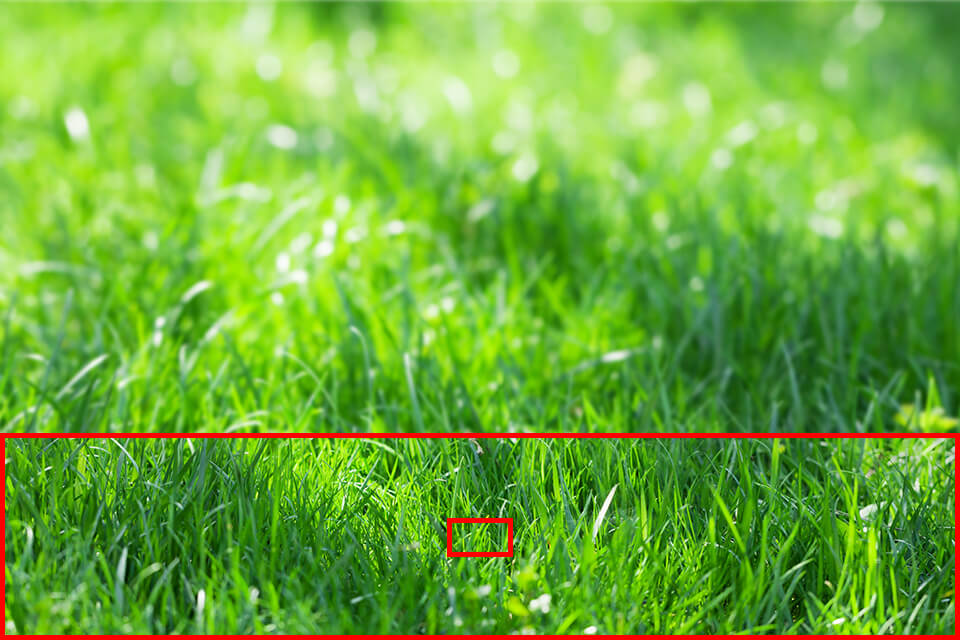
Focal Length in Photography
The focal length of the lens is a specific parameter that controls the angle of view. It is measured in millimeters. The Field of View, also known as F.O.V, incorporates all the objects you can see through the viewfinder at a particular focal length.
The longer focal length you set, the smaller field of view you have. It allows you to zoom in the subject and make a clear focus on it. This method is perfect for shooting close-ups of animals.
If you set a shorter focal length, you will get a larger field of view. It allows you to zoom out the scene to show more details. This method works great while taking landscape photos. The focal length depth of field concepts depend on each other. The focal length has a substantial impact on the depth of field.
It is possible to adjust the focal length just by setting the needed F.O.V. This defines the outermost boundaries of the composition in the picture. A shooter can choose both the max and min focal lengths for a particular camera lens.
Exposure Stops & F-Stops
Exposure stops and f-stops are other factors affecting the depth of field. An exposure stop (known also as a stop) is a universal scale that denotes the amount of light entering the image sensor.

Exposure stops affect ISO. They provide doubling or halving of the light signal or determine how much light the sensor needs to produce the optimum exposure.
In general, the stops enable a photographer to adjust the brightness of the picture, aperture, ISO, and shutter speed to achieve the desired result.
While examining the Stops Column, you can see the difference between various f-stop values. In F-Stop Value Column, there are standard f-stops in 1 stop intervals. Particular stops don't affect particular f-stop values.
With the help of stops, you can assess light information produced by one f-stop setting and compare it to another.
This makes it easy to boost or lower the image brightness and balance the exposure triangle without guessing.
- Learn more about real estate photography camera settings.
By increasing the f-stop number, you will decrease the size of the aperture and enable the image sensor to reduce the amount of light entering the lens. Thus, you will achieve a darker photo with DOF increased. In photography, this concept is known as stopping down.
By decreasing the f-stop number, you will increase the size of the aperture and enable the image sensor to increase the amount of light entering the lens. As a result, you will get a brighter photo with DOF reduced. Photographers call this phenomenon as stopping up.
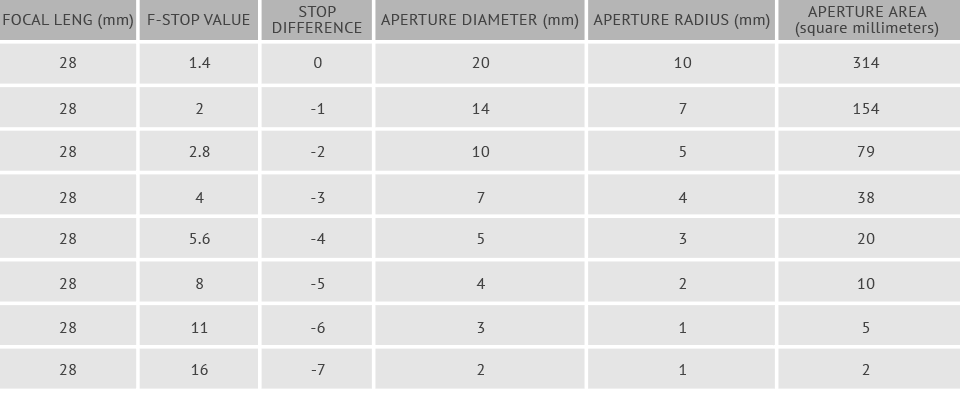
Increasing 1 stop means doubling the amount of light reaching the image sensor. This produces a brighter exposure and decreased DOF. Decreasing 1 stop means halving the amount of light hitting the image sensor. This results in darker exposure and increases DOF.
Aperture Diameter & Exposure Stops
In addition to the aperture depth of field, you need to know about the aperture diameter. It measures the amount of light reaching the lens and is determined by f-stop and focal length.
Looking at the graphic below, you can see that in terms of f-stop, the total aperture area determines the overall amount of light reaching the image sensor.
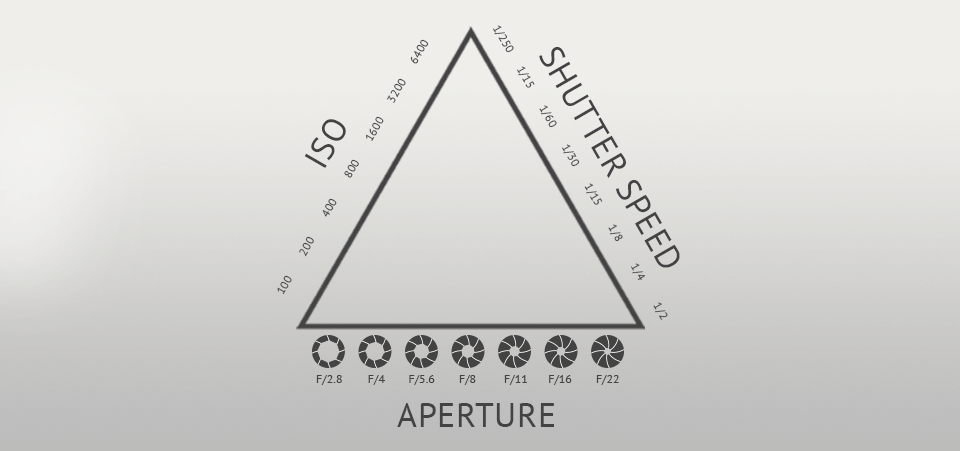
For instance, if you shoot at f/1.4, you will get a 314mm aperture hole for light to reach the digital image sensor.
If you increase the f-stop to f/2, it reduces the opening to 154 square millimeters. This means the amount of light entering the lens will be reduced by half. In this case, the stop difference is 1.
If you change the f-stop to f/16, you will get 77 times less light entering the lens compared to f/2. Look at Aperture Area Column and make simple calculations to see everything yourself. 154/2 = 77. In this case, the stop difference is 6.
By rating varying f-stop numbers on the stop scale, you don’t need to make calculations.
How to Select F-Stop and Depth of Field?
These samples demonstrate various image attributes and their correlation with varying f stop depth of field values. An image attribute can be defined as a particular visual effect that can be achieved by varying “exposure triangle” settings.
I will consider the attributes of the visual image, defined by f-stop which enables increasing and decreasing the depth of field. As soon as you increase the f-number, the aperture opening will get smaller.
This way, less light will pass through the lens resulting in the increased depth of field. Conversely, as soon as you reduce f-number, the aperture opening will increase. In this case, more light will reach the camera resulting in the decreased depth of field.
Small F-Stop Values
 Photo by Anne Geier. Settings: ƒ/2.2, 1/1000s, ISO 200
Photo by Anne Geier. Settings: ƒ/2.2, 1/1000s, ISO 200
If you shoot at f/1.4, you will get a photo with a small DOF. This will work great if you plan to put all of the focus on your subject.
Selecting f/1.4 will result in a bigger aperture diameter, which lets more light in. If you are shooting at the daytime, it is better to use fast shutter speed in order to balance the amount of light passing through the aperture opening.
 Photo by Daniel Parent. Settings: 400mm, ƒ/2.8, 1/2000s.
Photo by Daniel Parent. Settings: 400mm, ƒ/2.8, 1/2000s.
If you set f-stop at f/2.8, you will get the same effect but the scene will look sharper. As you can see in the picture, the fisherman and the boat are sharp, but the foreground and distant background elements appear blurry. You can also set this f-stop value to photograph the night sky.
F-stops like f/4- f/5.6 allow you to get a deeper DOF and blurred background or foreground. However, the result depends on the location of the focal point. The photo below was taken at f/5.6. Here the foreground is in focus, the buildings appear slightly blurred and the distant background is soft and out-of-focus.
The buildings in the background have catchy elements, so the photo was taken at f/5.6 instead of f/2.8. The buildings are in partial focus which made the picture look attention-grabbing and professional.
Mid-Range F-Stop Values
 Photo by Thomas Norberg. Settings: 16mm, ƒ/13, 15s.
Photo by Thomas Norberg. Settings: 16mm, ƒ/13, 15s.
I set the f-number between f/8 and f/11 while taking almost all my photos. This way I get a shallow DOF which is perfect for shooting landscapes. The photo below was shot at f/11. As you see, both the close foreground and distant background are sharp.
Large F-Stop Values
 Photo by Sony Alpha a7. Settings: 55mm, ƒ/16, 15s.
Photo by Sony Alpha a7. Settings: 55mm, ƒ/16, 15s.
Sometimes photographer needs to use longer shutter speed or large DOF. In this case, I recommend shooting at f/11 and higher. To increase shutter speed and create a “silky water” effect, I took a photo at f/16.
F-stop value like F/16 decreased the amount of light passing through the lens and required a slower shutter speed to preserve image brightness.
 Photo by Canon EOS 5D Mark II. Settings: 70mm, ƒ/18, 1/100s.
Photo by Canon EOS 5D Mark II. Settings: 70mm, ƒ/18, 1/100s.
Photographing at f/22 creates lens diffraction which produces a visible loss of image quality. However, this way you can get a sun star effect in your photos. So, I recommend shooting at f/22 only for the purpose to get a sun star effect or to change the overall exposure in the photo.
How to Read a Camera Lens?
Before you adjust f stop and depth of field, it is necessary to learn basic information about a camera lens to get the desired result.
Wide Angle, Standard, & Telephoto Lenses
The human eye has a focal length of about 50mm. If the focal length is bigger than 50 mm, you will get a smaller field of view with the objects appearing closer.
If the focal length is less than 50mm, we are talking about a “wide angle view”. This describes a wider field of view than human eyes can perceive.
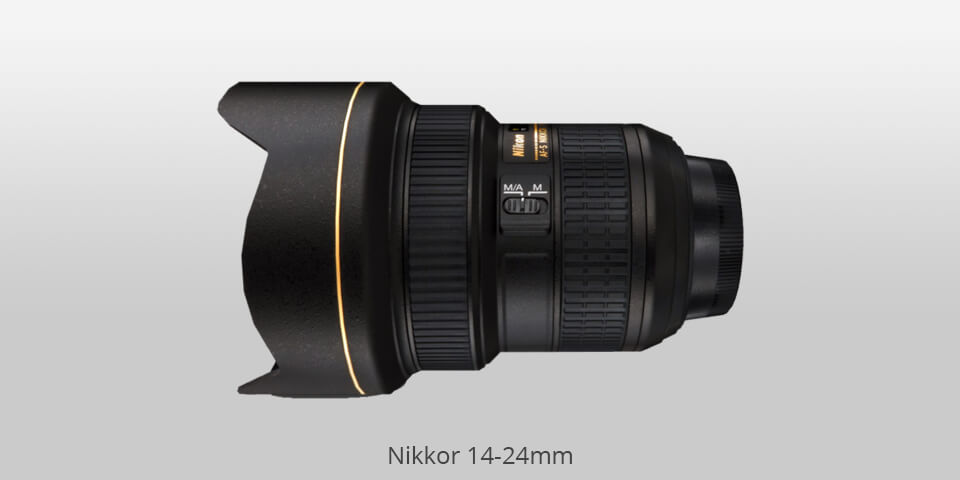
This field of view makes your subjects appear smaller and somewhat distorted comparing to the human vision.
Wide Angle Lenses create a field of view that is larger compared to standard human vision. This type of lens has a focal length which varies from 8mm to 35mm.
Standard Lenses give a field of view that matches what human eyes can see. Standard lenses have a focal length range from 40mm to 60mm.
Telephoto Lenses give a narrow field of view that is smaller than what human eyes can see. In this case, the focal length is over 70 mm.
Focal Length Meaning
I chose the lens randomly. You can use this information to read any camera lens available on the market.
Look at the graphic below. Here you can see Nikkor 28-300mm which focal length varies from 28mm to 300mm. Such type of lens refers to Wide Angle Zoom Lens because it produces a wide F.O.V and allows you to magnify the subjects.
If you don’t know how the focal length is measured, you can see the range on the side of the lens. As for Nikkor 28-300mm, the focal length range is marked with small gold letters right above the “AF-S NIKKOR” label.
It is possible to set any focal length ranging from 28mm to 300 mm. Changing the focal length, you will change the field of view.
I selected the 28mm focal length on Nikkor 28-300mm. (Look at white dot on the adjustable barrel).
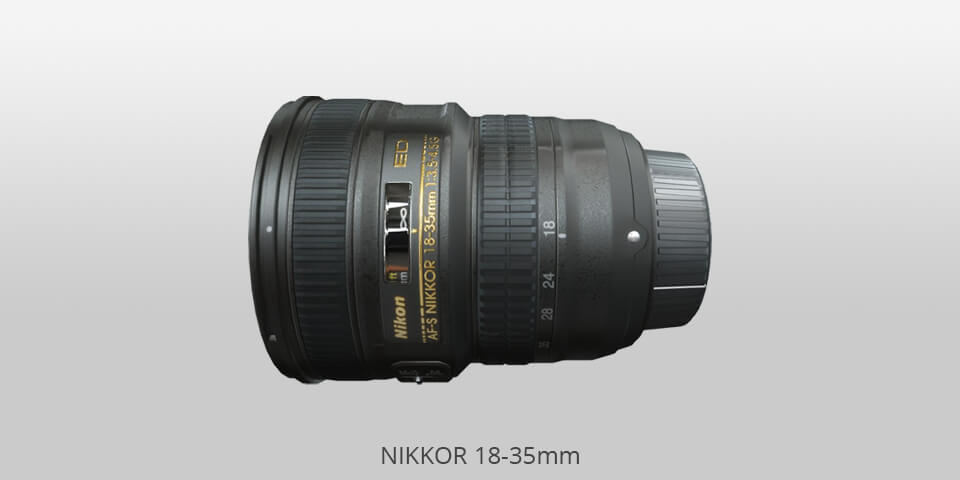
The wide-angle lens refers to a lens in which focal length is significantly smaller, such as 14 mm. The telephoto lens has a considerably large focal length which varies from 135mm to 300mm.
It is worth noting that the smaller focal length you select, the larger FOV you get and vice versa.
- Learn more about camera settings for product photography.
Effective Focal Length
The effective focal length is another aspect that affects the understanding of aperture and depth of field. If you want to effectively change the focal length, it is recommended to shoot on cameras featuring crop factors.
By setting the appropriate crop factor, you can change the field of view, and correspondingly, the focal length. Here is an example of a handy focal length calculation.
If you have a 1.6 crop factor camera and a 28-300mm lens, just follow this formula to calculate the best focal length: (28mm X 1.6) – (300mm X 1.6). In this case, the EFL ranges from 45mm to 480mm.
The picture below was shot at 14mm on a full-frame camera with 1 crop factor. If you shoot at 14 mm on a camera with a 1.6 crop factor, you will get a photo that looks like it was photographed at 22mm (14mm X 1.6).
In the photo sample, the red box shows what the image would look like if it was taken on a camera with a 1.6 crop factor.
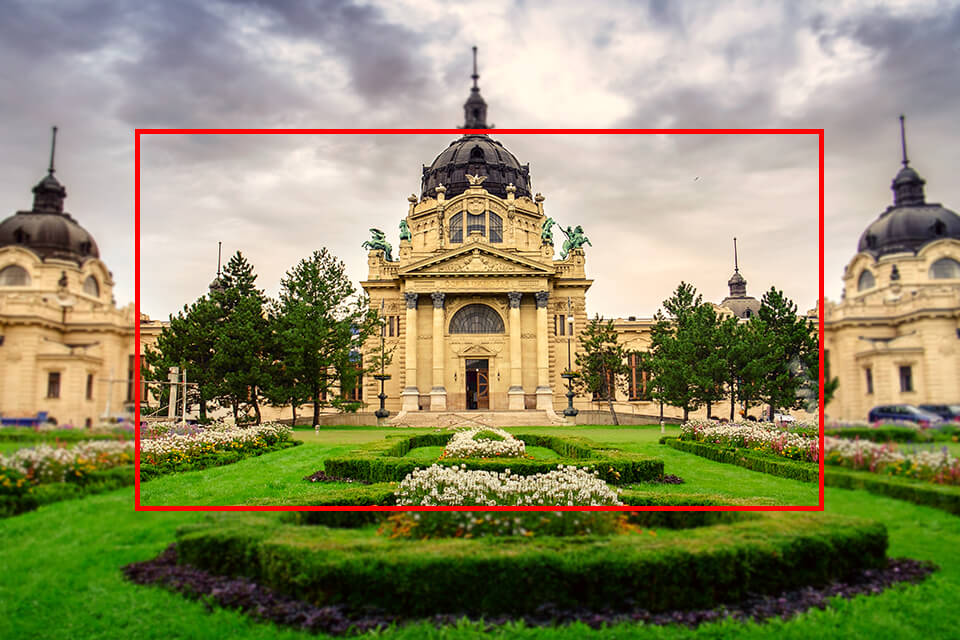
There are professional cameras that are capable of adjusting their sensor sizes and, consequently, changing their crop factors as well as effective focal lengths.
For instance, when taking photos with a full-frame camera paired with a 28–300mm lens, you can adjust the crop factors to increase the zoom to 480 mm (300mm X 1.6). This might be helpful if you are planning to shoot distant subjects but don’t want to use a telephoto lens.
Increasing crop factors, you may lose some details in the composition, but depending on the situation, your picture may benefit from it.
F-Stop Value
Different camera lenses feature different maximum and minimum f-stop values. The majority of lenses allow you to increase the f-stop value along with focal length.
Here the focal length range is defined as 18-35mm. You can photograph at any possible focal length within this range to get the most suitable field of view.
There is a minimum f-stop range next to the focal length range. On this lens, it is determined as f/3.5 to f/4.5. The letter “G” that appears near the minimum f-stop range doesn’t refer to the f-stop number.
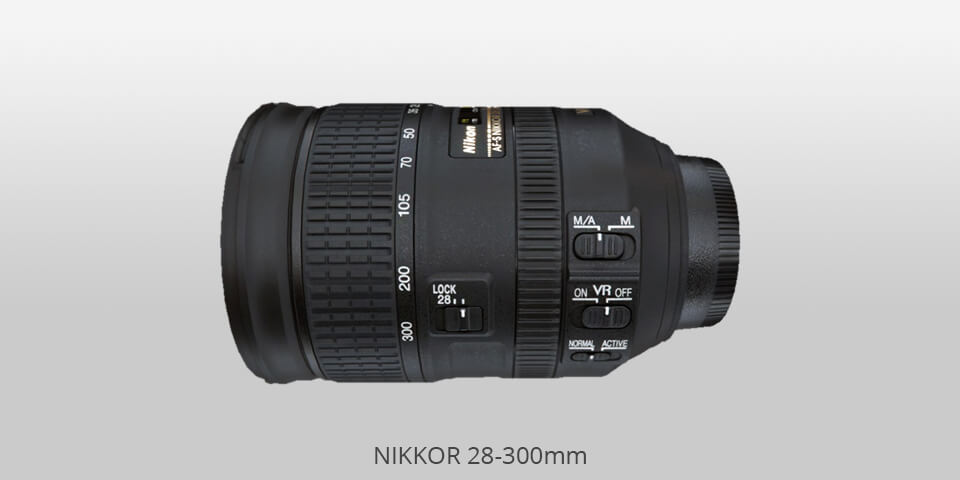
The minimum f-stop values range of f/3.5 to f/4.5 is enough for this lens model to shoot at the min and max focal lengths.
For instance, the min f-stop value this model supports is f/3.5 while photographing at 18mm. If you increase the focal length to 35 mm, the minimum f-stop will increase to f/4.5 as well. All focal length values between 18mm and 35mm will always have a minimum f-stop of f/3.5 to f/4.5. Of course, it is possible to set higher values. I just provided examples of minimum values.
Lens Speed Basics
Apart from the aperture and depth of field notions, every photographer should learn lens speed basics. The f-numbers labeled on the lens are also known as lens speed. So, the specialists determine lens speed as the largest aperture diameter or the minimum f-stop number of a particular lens.
When you increase the focal length from 18mm to 35mm, the aperture opening gets smaller, decreasing the f-number from f/3.5 to f/4.5. In order to gather the same amount of light information, it is necessary to set a slower shutter speed.
The shorter exposure time, the smaller the f-number the lens can maintain at the given focal length. For example, Nikkor 14-24mm f/2.8 Wide Angle lens features a single minimum f-stop value of 1:2.8. That means this model can operate at f/2.8 photographing at focal length range from 14mm to 24mm.
In addition, this particular lens is capable of preserving a constant minimum f-stop value of f/2.8, if necessary. However, fixed aperture lenses are usually expensive.
Remember about the highest f-stop value or the smallest aperture diameter. You can find these values labeled on the lens because they alter the maximum limits of lens speed and shutter speed.
- Check out more information about Nikon portrait lens.



